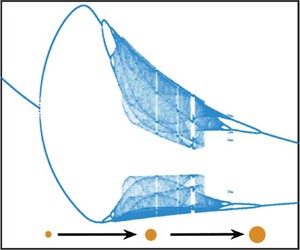Article contents
Trapping and extreme clustering of finitely dense inertial particles near a rotating vortex pair
Published online by Cambridge University Press: 04 October 2024
Abstract

Small heavy particles cannot be attracted into a region of closed streamlines in a non-accelerating frame (Sapsis & Haller, Chaos, vol. 20, issue 1, 2010, 017515). In a rotating system of vortices, however, particles can get trapped (Angilella, Physica D, vol. 239, issue 18, 2010, pp. 1789–1797) in the vicinity of vortices. We perform numerical simulations to examine trapping of inertial particles in a prototypical rotating flow described by a rotating pair of Lamb–Oseen vortices of identical strength, in the absence of gravity. Our parameter space includes the particle Stokes number  $St$, which is a measure of the particle's inertia, and a density parameter
$St$, which is a measure of the particle's inertia, and a density parameter  $R$, which measures the particle's density relative to the fluid. In particular, we study the regime
$R$, which measures the particle's density relative to the fluid. In particular, we study the regime  $0< R<1$ and
$0< R<1$ and  $0< St<1$, which corresponds to an inertial particle that is finitely denser than the fluid. We show that in this regime, a significant fraction of particles can be trapped indefinitely close to the vortices, and display extreme clustering into objects of smaller dimension: attracting fixed points and limit cycles of different periods including chaotic attractors. As
$0< St<1$, which corresponds to an inertial particle that is finitely denser than the fluid. We show that in this regime, a significant fraction of particles can be trapped indefinitely close to the vortices, and display extreme clustering into objects of smaller dimension: attracting fixed points and limit cycles of different periods including chaotic attractors. As  $St$ increases for a given
$St$ increases for a given  $R$, we may have an incomplete or complete period-doubling route to chaos, as well as an unusual period-halving route back to a fixed point attractor. The fraction of trapped particles can be a non-monotonic function of
$R$, we may have an incomplete or complete period-doubling route to chaos, as well as an unusual period-halving route back to a fixed point attractor. The fraction of trapped particles can be a non-monotonic function of  $St$, and we may even have windows in
$St$, and we may even have windows in  $St$ for which no particle trapping occurs. At
$St$ for which no particle trapping occurs. At  $St$ larger than a critical value, beyond which trapping ceases to exist, significant fractions of particles can spend long but finite times in the vortex vicinity. The inclusion of the Basset–Boussinesq history (BBH) force is imperative in our study due to the finite density of the particle. We observe that the BBH force significantly increases the basin of attraction over which trapping occurs, and also widens the range of
$St$ larger than a critical value, beyond which trapping ceases to exist, significant fractions of particles can spend long but finite times in the vortex vicinity. The inclusion of the Basset–Boussinesq history (BBH) force is imperative in our study due to the finite density of the particle. We observe that the BBH force significantly increases the basin of attraction over which trapping occurs, and also widens the range of  $St$ for which trapping can be realised. Extreme clustering can be of significance in a host of physical applications, including planetesimal formation by aggregation of dust in protoplanetary discs, and aggregation of phytoplankton in the ocean. Our findings in the prototypical model provide impetus to conduct experiments and further numerical investigations to understand clustering of inertial particles.
$St$ for which trapping can be realised. Extreme clustering can be of significance in a host of physical applications, including planetesimal formation by aggregation of dust in protoplanetary discs, and aggregation of phytoplankton in the ocean. Our findings in the prototypical model provide impetus to conduct experiments and further numerical investigations to understand clustering of inertial particles.
Information
- Type
- JFM Papers
- Information
- Copyright
- © The Author(s), 2024. Published by Cambridge University Press
References
- 1
- Cited by


